If you want to learn how to buy Amazon return pallets and transform them into a profitable business, you’re in the right place.
I wrote this guide to provide you with valuable insights into the world of Amazon return pallets, where to purchase them, securing great deals, and reselling refurbished items.
Let’s get started.
What Are Amazon Return Pallets, and Can You Buy Them?

If you’re wondering, “Are Amazon return pallets real?” Yes. They are.
Amazon return pallets are enormous pallets full of returned items that the popular ecommerce store resells at a discounted price.
These boxes may contain opened, used, or damaged items, but they’re not necessarily unusable.
They’ve gained popularity because of Amazon’s generous free returns shipping policy, leading to a higher number of returned merchandise.
Amazon doesn’t share its return rates with the public. In general, however, data suggests that approximately 30% of ecommerce purchases are returned.
By comparison, brick-and-mortar stores have a return rate of only 8.89%.
Consumers return their purchases for various reasons, such as:
- Damaged product – 20%
- Product doesn’t meet expectations – 22%
- Wrong item – 22%
- Other reasons – 26%
With such a high return rate, Amazon has more merchandise on their hands than they know what to do with.
What Does Amazon Do with Returns?
Major retailers like Amazon usually collect customer returns and transport them back to warehouses.
Amazon first inspects the products, then do any of the following steps:
- Resell or relist products in good condition.
- Return them to the original seller, who can then decide whether or not to relist these items.
- Dispose the products in landfills.
- Donate them through various ways, including via the FBA Donations program that donated over 100 million products in 2022.
- Transport the returns back to warehouses and pack them together in large pallets, which they sell to liquidation companies.
Amazon regains a portion of their lost profit by selling the returned items at prices lower than the items’ retail prices. This gives small businesses and resellers access to the discounted merchandise, which can include unused and branded products.
What’s Inside an Amazon Return Pallet?
The various Amazon return boxes in a pallet usually contain random merchandise, including clothes, kitchen appliances, electronics, video games, beauty products, toys, home improvement items, and car parts.
Liquidation sites often include general product descriptions and photographs when selling Amazon return pallets online.
Most companies also have categories sellers can browse when looking for liquidation merchandise.
Here’s an image of an actual Amazon return pallet auction at Liquidation.com, a popular online liquidation marketplace.
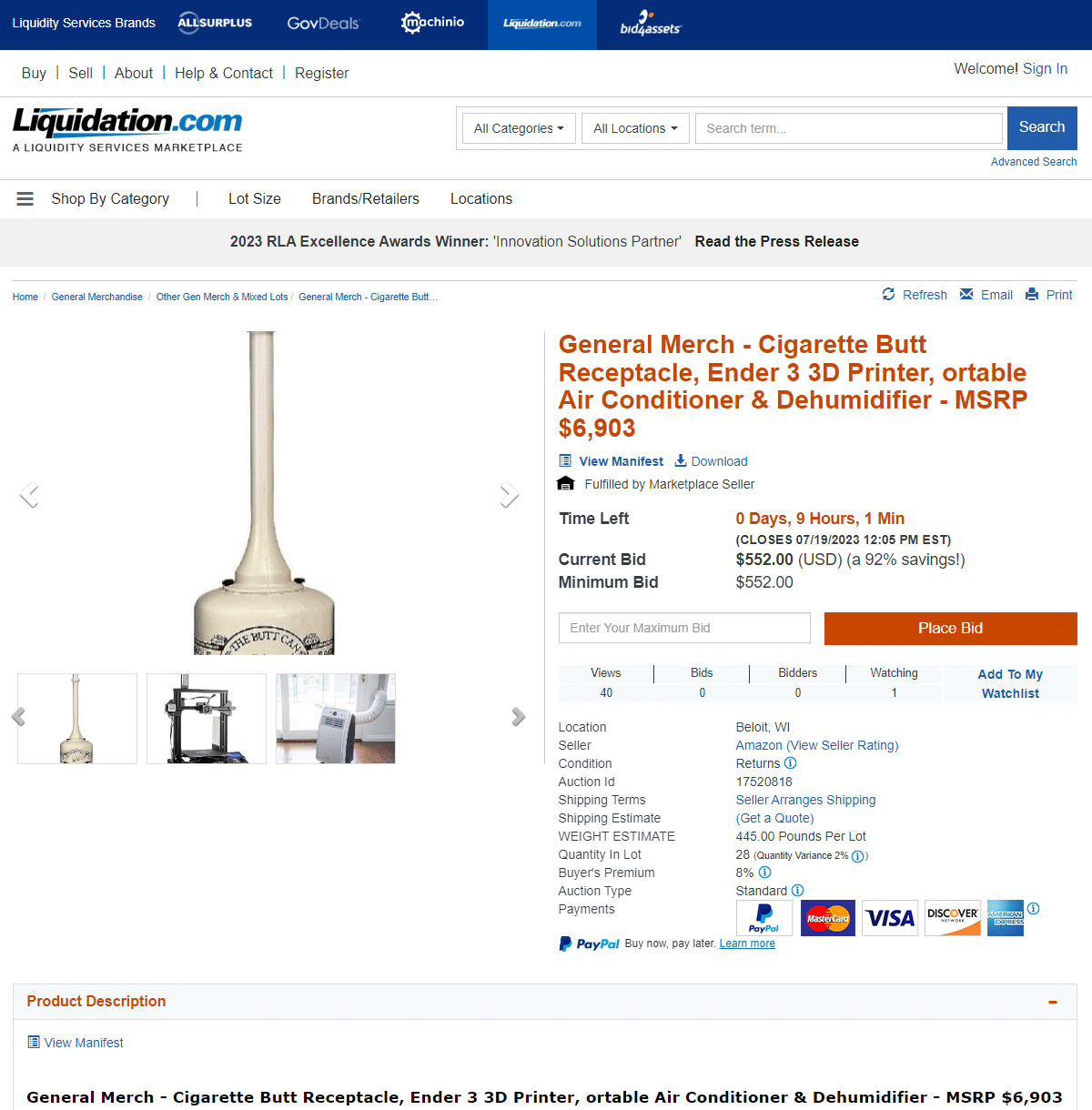
Liquidation.com’s online listings for returned items include a product description section with unit highlights describing the pallet’s most high-value items. You can also look at manifests detailing the products’ description, quantity, and price.
These listings are also known as manifested listings.
Here’s an image of an actual return pallet manifest.
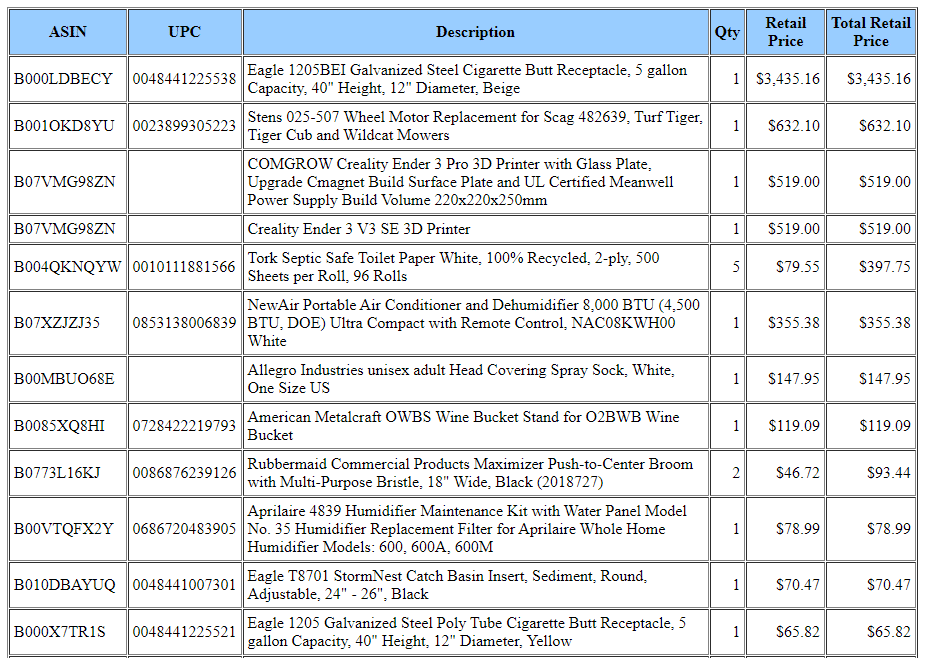
Note: This image doesn’t contain all the items listed on the manifest.
What Are Amazon Mystery Pallets?
While manifested listings are common, you may also encounter Amazon mystery pallets.
Some liquidation companies and auction sites offer return pallets from Amazon without disclosing the items, their prices, and their condition, hence the term “Amazon mystery pallet.”
The selling price for these pallets is often lower than manifested return pallets to attract buyers.
As a seller, you may be tempted to buy pallets without knowing what’s inside because they’re cheap. However, there’s considerable risk in doing so.
The items in mystery pallets can be damaged, low-quality, and missing certain parts. You can’t resell these items, meaning you may lose your investment when buying mystery pallets.
While making money off an Amazon return mystery box isn’t impossible, you must be ready for potential losses.
One thing you can do to mitigate risks is to conduct thorough research before buying. Purchase only from reputable websites or companies, not random individuals online.
How Much Does It Cost To Buy an Amazon Return Pallet (More Than You Think)?
Liquidation sites auction off returned items. Thus, the cost of buying an Amazon return pallet can vary according to the number of bids it has and the price of the bids.
Starting bids for Amazon pallets can range from $100 to $1,000, depending on the item type, number, and condition.
Generally, you can expect to spend a few hundred to approximately $5,000 when buying Amazon return pallets. However, some Amazon return pallets cost over $10,000.
How To Buy Amazon Return Pallets Online
Here are the easy steps on how to buy returned items from Amazon:
- Get a resale certificate.
- Research liquidation companies.
- Review the listings and item conditions.
- Calculate your shipping costs.
1. Get a Valid Resale Certificate.
If you’re a US-based entrepreneur, liquidation sites will require you to submit a copy of a valid reseller certificate to register on their websites and let you bid on online auctions.
For international customers, liquidation websites require a valid business registration or license.
A resale certificate is a signed document stating that you plan to resell the goods you purchase and collect sales taxes from customers when you sell those items.
Contact your state’s tax department to apply for a resale certificate if you don’t have one. Liquidation websites won’t let you register and bid without it.
2. Look for Reliable Liquidation Companies.
Whether you plan on buying online or onsite via physical liquidation stores, read reviews to learn what you can expect from different liquidation companies.
Look for a reputable seller with a history of providing accurate product descriptions and good customer service.
Do other resellers say a certain company is selling overpriced pallets? Are they always receiving broken merchandise from another company?
I’ll let you in on the most reliable liquidation platforms later, so keep reading.
3. Review the Listings and Item Conditions.
Once you’ve narrowed your list of potential liquidation websites, check their listings to see what they offer.
Check the categories on liquidation sites to see if they have returned items from Amazon that suit your niche.
For example, if you sell refurbished or second-hand electronic items, you need a liquidation site offering consumer electronics, computers, and other similar categories.
Read the information included in listings, which vary by listing liquidation platform.
Some listings have detailed manifests, while some don’t. Some sites include the condition of the items and let you filter results accordingly, while some don’t.
Buying return pallets is a gamble. Nevertheless, you can increase your chances of scoring good deals with these tips:
- Diversify your selection.
Choose Amazon return crates that contain a mix of items. This reduces the risks of getting items in certain niche markets. - Evaluate return rates.
Research on Amazon the return rates of specific products and categories. Products with lower return rates tend to have a higher resale value. - Set a reasonable budget.
Avoid overextending your finances, especially when you’re just starting. A conservative budget can reduce financial risks and allow you to explore this venture carefully. - Keep an eye on for discontinued or rare products.
Many collectors actively seek these items and are willing to pay a premium for them.
You might also want to keep an eye out on the bestselling items on Amazon.
For reference, here are the most popular categories on Amazon Prime Day in 2022:
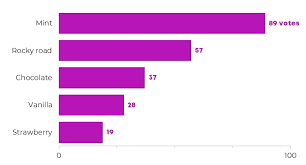
[Please design a bar graph with the following data:]
- Products for the home – 32%
- Makeup and skincare – 30%
- Clothing or accessories – 29%
- Gaming tech gadgets (e.g. Oculus, Xbox) – 22%
- Consumer tech (e.g. smartwatch, AirPods) – 18%
- Others – 37%
Data source: Statista
That said, you must manage your expectations. You might get some merchandise ready for resale immediately, while some may need repairs.
4. Calculate Your Shipping Expenses.
The shipping costs can make or break your decision to buy returned merchandise because the shipping cost is sometimes higher than the Amazon pallet price.
Shipping policies vary by company, but most allow you to arrange your own shipping via a third party. Include the cost of shipping into your budget before bidding on any listing.
If you don’t want to purchase returned merchandise online and pay for shipping, you can look for nearby onsite liquidation stores.
Some liquidation companies also let you pick up purchased merchandise at one of their physical locations.
Consider this option if it’s available and if you have a vehicle large enough to transport the goods. You can also rent a van or a truck, which will likely be cheaper than shipping the items.
Where To Buy Amazon Return Pallets
Wondering where to find these pallets? You have several options, including Amazon itself, liquidation companies, online marketplaces, and more.
Here’s a summary:
| Liquidation Platform | Pros | Cons |
|---|---|---|
| B-Stock | Auctions are available for various regions, including the US, Canada, and Europe Official Amazon partner | Overpriced stocks, according to some buyers. |
| Liquidation.com | Reliability as one of the oldest liquidation platforms Various product categories Inventory from an extensive range of retailers | Untested products without the original packaging |
| BULQ | No auctions, fixed price Contains a list of the exact items | Uninspected returns Fewer options |
| Direct Liquidation | One of the oldest and most popular liquidation platforms Has one of the most extensive product ranges | Untested and unrepaired products Manifests can aren’t 100% accurate |
| 888 Lots | Amazon profit calculator tool Offers special deals and discounts | Only caters to US buyers Reviews reporting damaged items and poor customer service |
| Liquidation Warehouses | Physical inspection before purchase Potential for direct negotiation with sellers Access to diverse pallets | Limited geographic availability In-person visits may be time-consuming |
| Facebook Groups | Direct interaction with sellers Potential for local deals and pickup options May have lower competition | Limited product information Limited buyer protection Less structured buying process |
| Online Marketplaces | Convenient platform for purchasing return pallets from the comfort of your home Multiple sellers with a diverse range of options | Less control over product selection Higher uncertainty and risks |
1- Liquidation Websites
B-Stock Supply and Amazon Liquidation Auctions
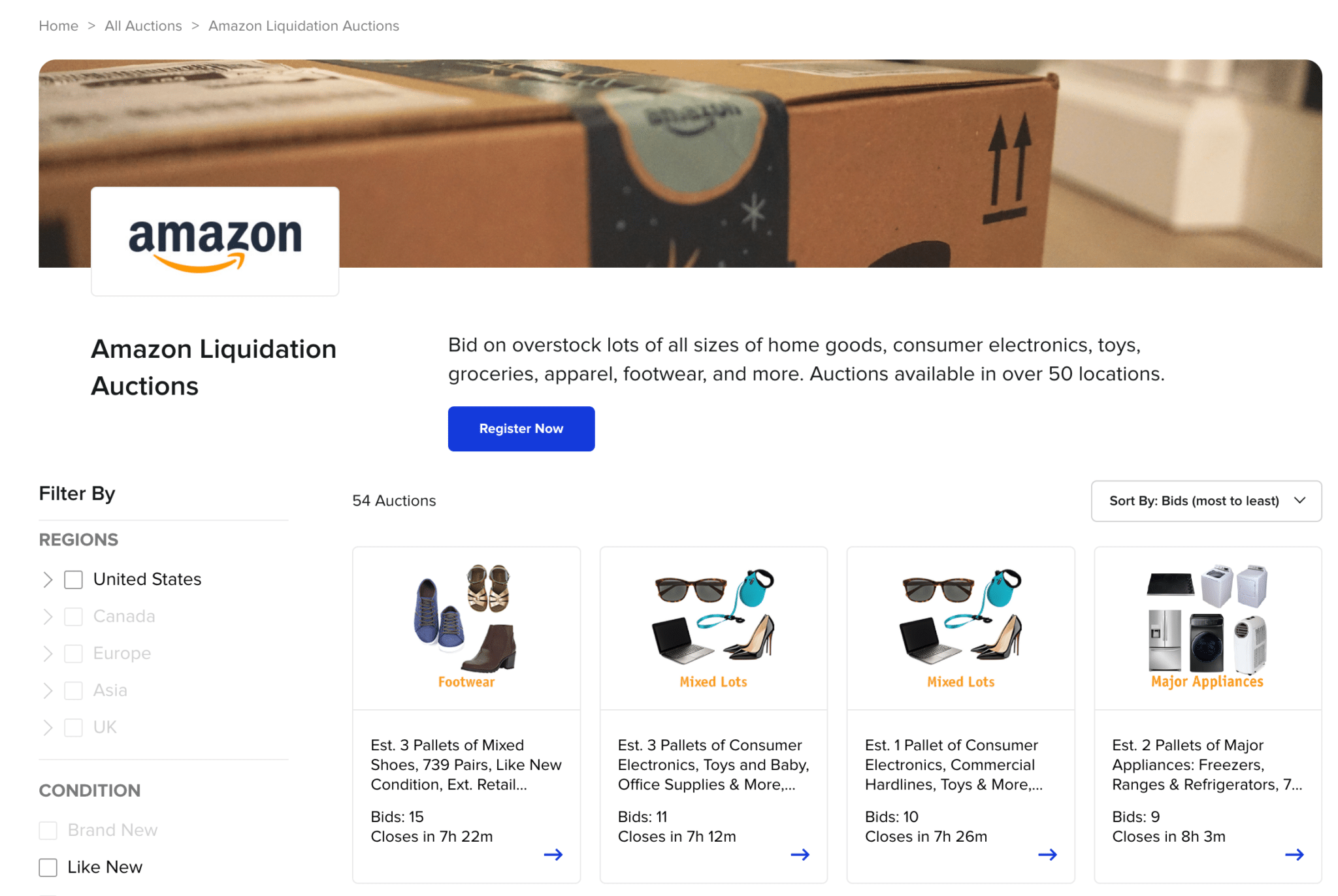
Liquidation company B-Stock partnered with Amazon in 2018 to launch Amazon Liquidation Auctions.
Being an official Amazon partner, B-Stock is one of the best places to buy Amazon returned packages. It also offers mixed lot liquidation auctions for the US, Canada, Europe, and Asia.
Besides Amazon Liquidation Auctions, this company offers other liquidation inventory from retailers like Best Buy, Walmart, and Home Depot.
The site lets you shop by category, including apparel, jewelry, office supplies, and industrial equipment. You can also filter results by condition, including Like New, Used – Good, and Mixed Condition.
According to buyers, the downside of B-Stock is overpriced items and shipping fees.
Direct Liquidation
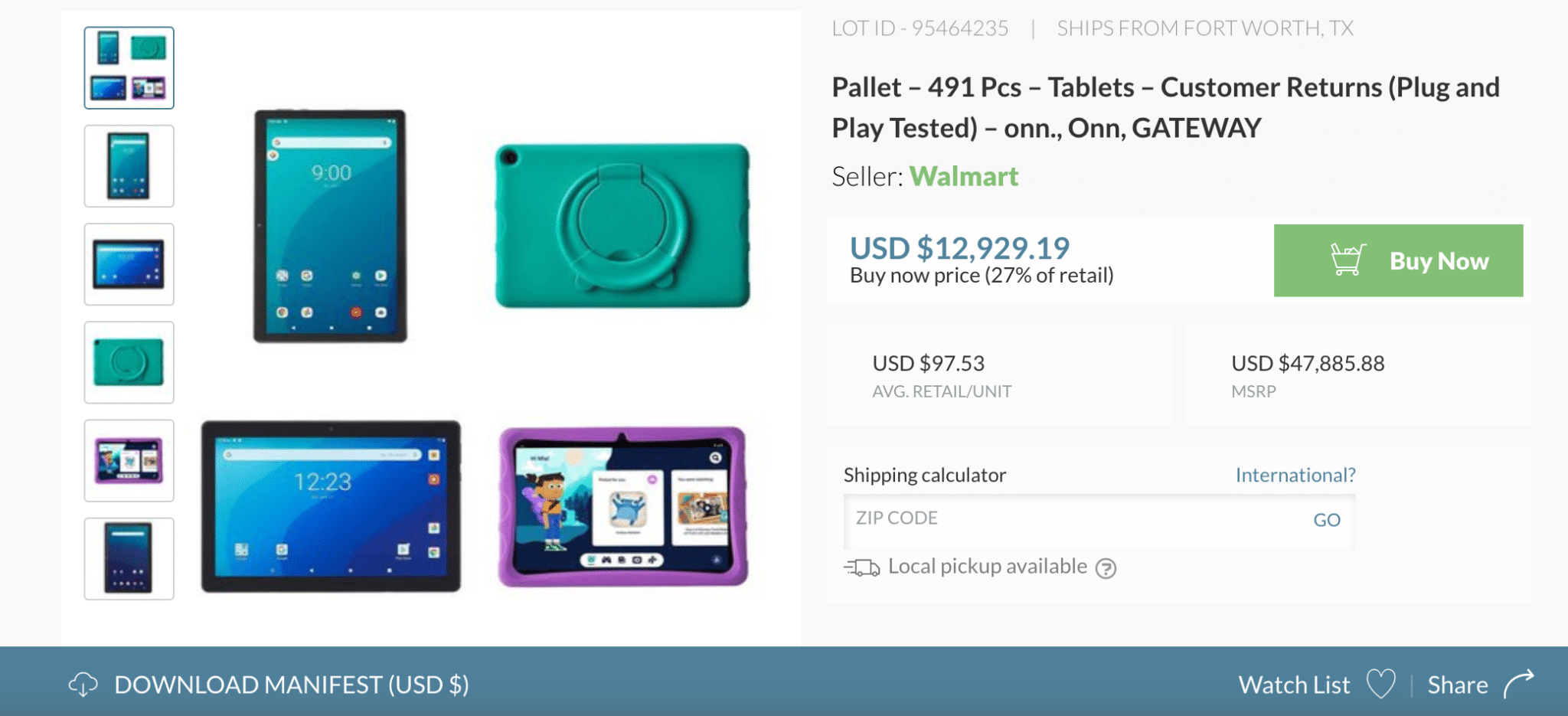
The website lets you search for Amazon warehouse pallets by department, including automotive, electronics, toys, industrial supplies, and baby products.
Aside from Amazon warehouse clearance pallets, this liquidation company also offers overstock inventory from retailers like Walmart, Sam’s Club, and JC Penney.
The downside: Typically, liquidated items on the site are untested and unrepaired, with packaging opened or missing. Furthermore, manifests aren’t 100% accurate.
However, the site states that returned items have a “75% plug-and-play success rate.”
Liquidation.com
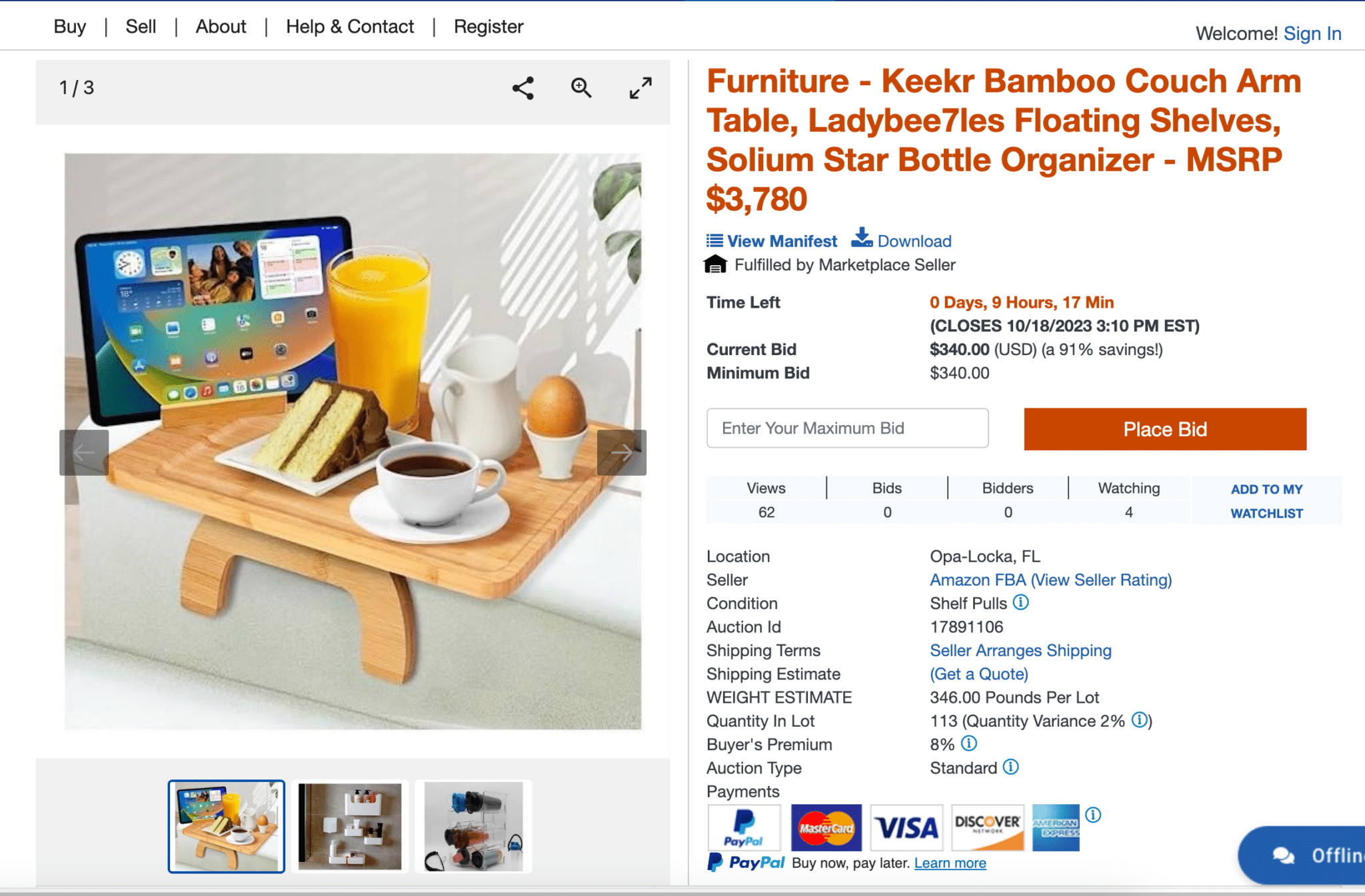
Liquidation.com is a direct liquidation website and Amazon wholesale pallet partner offering auctions to resellers.
They also buy overstock merchandise directly from retailers like Home Depot, Target, and Walgreens.
Liquidation.com offers various categories for customer returns pallets, including consumer electronics, furniture, general merchandise, and appliances.
However, the fine print in many of the site’s listings says the items are untested, often don’t include the original packaging or factory plastic wrapping, and may be in conditions that differ from the original manufacturing.
BULQ
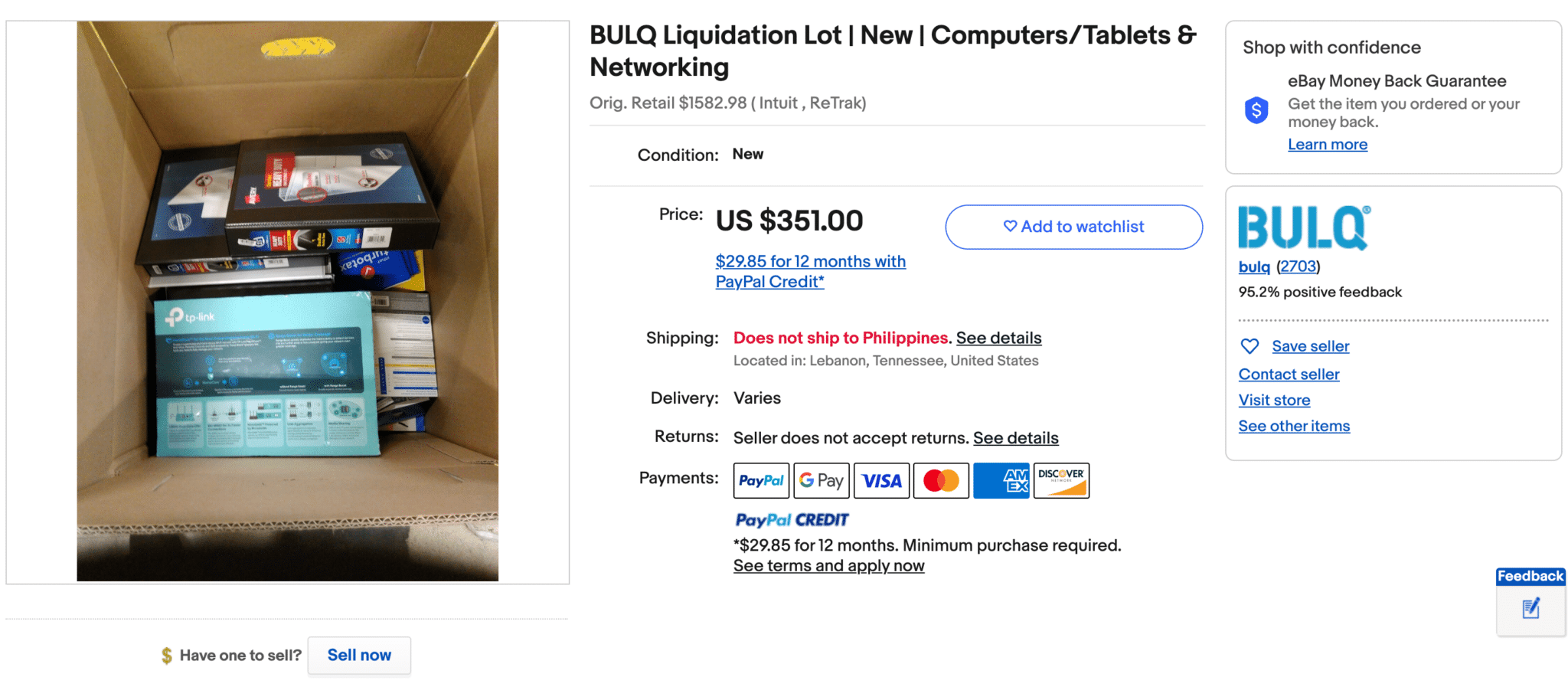
Most liquidation sites sell surplus inventory through auctions, but not BULQ.
It has a regular marketplace, where you can simply add to cart your desired pallets, then check out.
BULQ also provides more visibility into the pallet’s contents, unlike other sites. The manifests usually contain the exact items you’re going to get.
This way, you can choose to receive either random merchandise or specific products that cater to your niche.
However, most pallets are uninspected returns. There’s a higher risk of damaged or incomplete products, but there’s also a great chance of scoring brand new merchandise.
888Lots.com
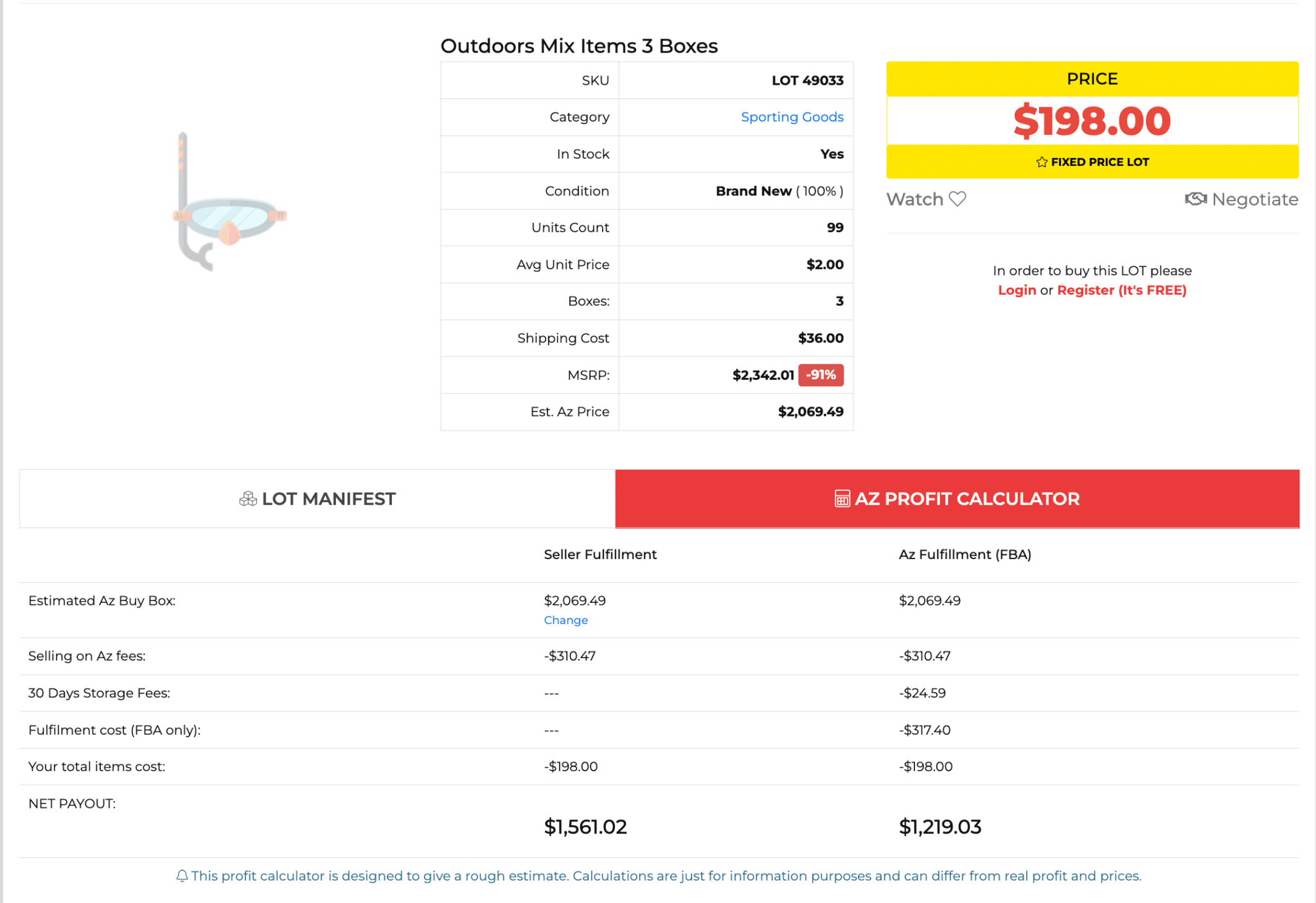
888 Lots is one of the oldest liquidation companies, buying excess inventory and selling them to online resellers, small businesses, and enterprises.
888 Lots offers great deals and discounts, letting you buy liquidated merchandise at a lower cost.
The site even has an Amazon profit calculator to help you decide if the items you want to purchase are worth reselling on Amazon.
What makes this site stand out is that you can buy individual products at a much lower price. Of course, you still assume the ever-present risk of receiving faulty or incomplete items.
The biggest downside of 888 Lots is it sells Amazon return pallets only to the US. Some buyers also report receiving damaged items and poor customer service.
2- Liquidation Warehouses
You can visit liquidation stores selling Amazon return pallets in your area if you don’t like online purchases for returned goods.
Onsite liquidation centers offer returned products, open-box items, and overstock inventory from Amazon third-party sellers and various retailers.
Unlike online sales, liquidation centers let you physically inspect items before buying, helping you make better buying decisions. Many stores will also let you plug in and test items only after purchasing them.
Popular liquidation stores include:
- Quicklotz
- Big Lots
- Bargain Hunt
How To Buy Amazon Return Pallets Near Me?
It’s easy.
There are liquidation stores in all 50 states, and Googling “liquidation stores near me” or “liquidation stores (your ZIP code)” will let you find the nearest onsite liquidation centers.
The bad news is that driving from store to store can be tiring while looking for the best deals.
Tip: Use the Liquidation Map Site.

The site doesn’t sell Amazon return pallets directly—it only provides you with a list of suppliers selling Amazon return pallets.
The good thing about the site is that it has a list of vetted suppliers to help you avoid wasting your time and money.
The site also has an extensive list of known scammers to help other online resellers avoid fraud.
Liquidation Map updates the list constantly to keep buyers and sellers informed.
One downside to Liquidation Map is it can be challenging to sort through the hundreds of listings on the site.
Facebook Groups
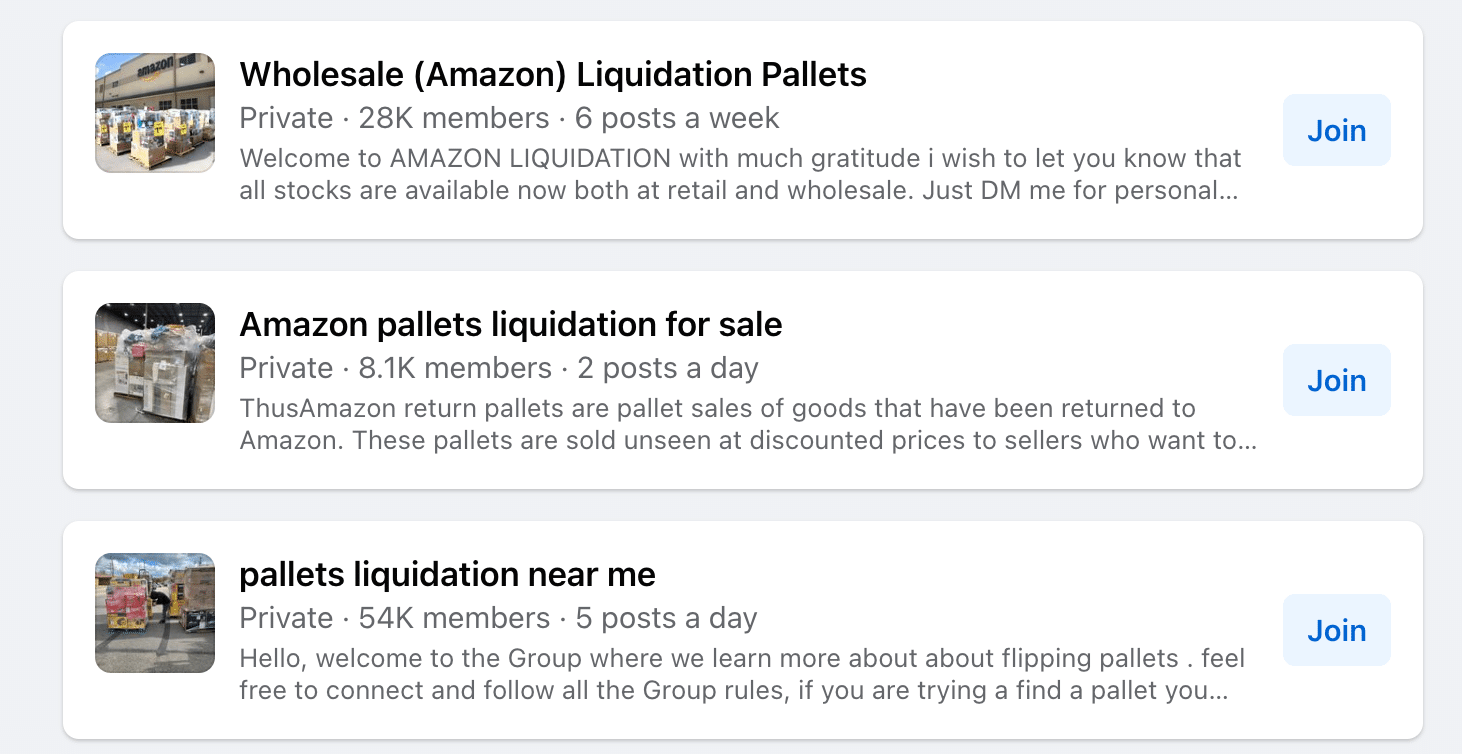
Facebook has dedicated groups for buying and selling Amazon return pallets. Members may sell pallets directly or provide tips on how to maximize your profits.
These groups provide an opportunity to connect with other resellers, share experiences, and find pallets in your local area.
Online Marketplaces
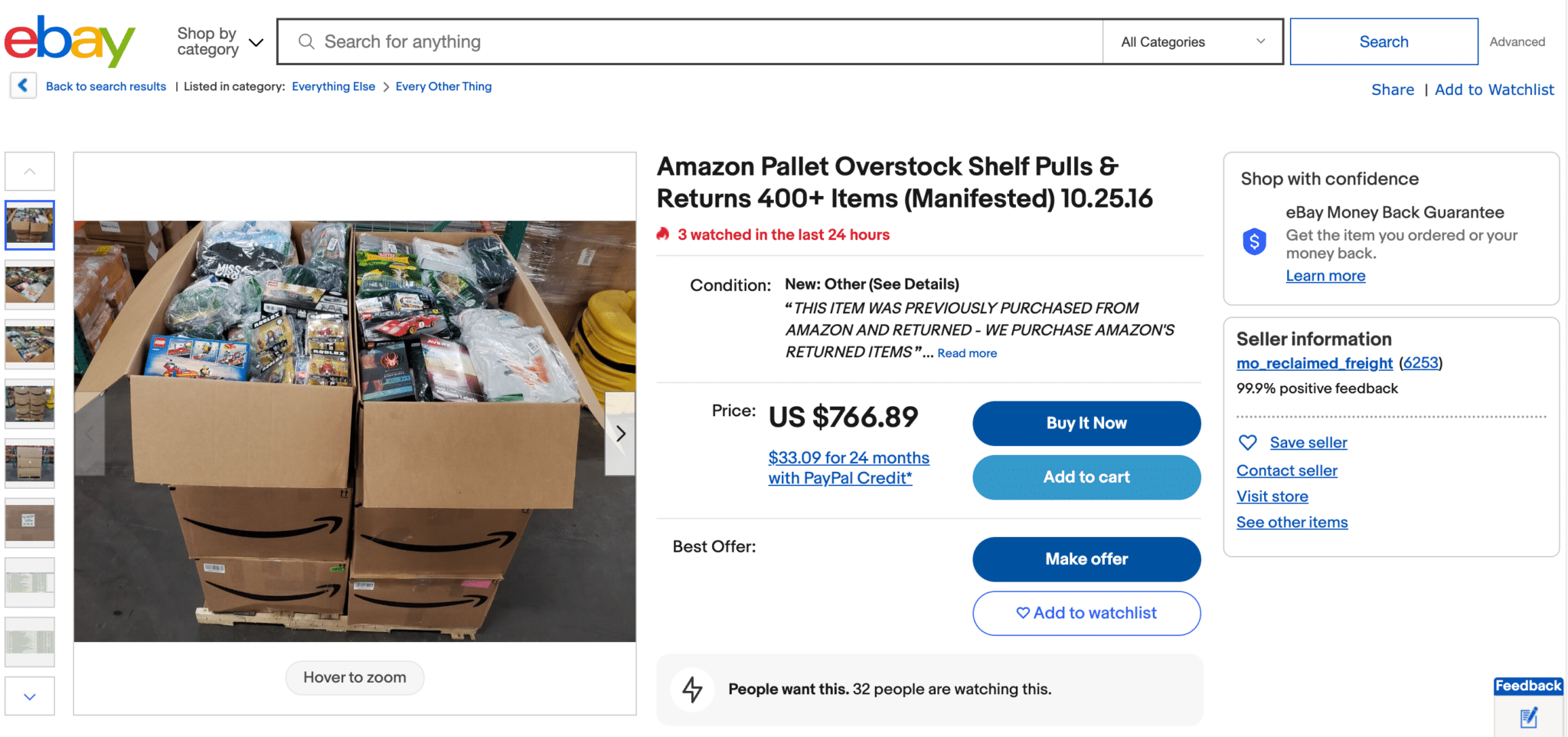
You can explore platforms like eBay and Craigslist to find a Amazon pallets for sale with different contents and conditions.
Keep in mind that purchasing from individual sellers on these platforms may involve more direct negotiation and transactional communication compared to working with established liquidation companies.
You must also be aware of the risks associated with buying from individual sellers on such platforms, such as limited recourse in case of issues or disputes.
Can I Buy Amazon Return Pallets From Outside the US?
Yes, but it depends on the specific liquidation company. Most companies require international buyers to submit a valid business license to register and bid on listings.
However, not all companies cater to non-US markets. For example, 888 Lots only works with buyers in the US.
Here are some liquidation companies to check out if you’re not in the US:
Canada
- Maxx Liquidation Solutions
- Directliquidations.com
UK
- Amazon EU Liquidation Auctions
- WholesaleScout
- Wholesale Clearance UK
- MartHill.co.uk
- Gemwholesale.co.uk
Outside of these regions, you might find some pallets through in-person auctions and online marketplaces.
I suggest joining Facebook groups in your area. I found an Amazon unclaimed pallet in garage sales once through a group.
You might also check out some sites that ship internationally, such as Liquidation.com (with exceptions).
How To Make Money on Amazon Return Pallets
The best way to profit from reselling customer returns is via retail arbitrage on Amazon.
Here are some tips.
You can sell the merchandise for profit in just four steps:
- Inspect your purchases.
- Repair and refurbish the products.
- Set competitive pricing.
- Resell at a higher price.
Let’s take a deeper look at each step for maximum profits.
Step 1: Inspect Your Purchases.
Once you’ve bought pallets, start by sorting the items.
Some resellers opt not to open unopened boxes to potentially sell them at a higher price since they’re still in new condition.
For the opened ones, you can check for any visible damage or issues. If your pallet contains electronics, test them to ensure they’re in working condition.
All throughout this step, ensure you keep detailed records of the items, their conditions, and your assessment.
This documentation simplifies the listing process and helps in providing accurate descriptions to potential buyers.
These are the most common categories resellers use:
| New factory-sealed | These items are brand new and remain sealed in their original packaging. They’re in pristine condition and typically have the highest resale value. |
| New open-box | They’re essentially new but with an opened packaging. The initial customer may have used it lightly, but it looks and feels brand new. |
| Refurbished | These items have been repaired or restored to like-new condition. |
| Used | They can vary widely in condition, from gently used with minimal signs of wear to heavily used with visible wear and potential defects. |
Step 2: Repair and Refurbish Products (Optional).
There’s always a risk of getting items that are damaged, not working, or missing certain parts.
If you’re handy with repairs or have a partner who is, you can significantly increase the resale value of these goods.
This is particularly true for high-end electronics like laptops, smartphones, and gaming consoles. By repairing and refurbishing these items, you can command higher prices and boost your profit margins.
Many resellers also actively choose fixer-upper pallets, which allow them to buy low and sell high.
Step 3: Set Competitive Pricing.
Research the market prices for similar or identical products. Explore online marketplaces, such as Amazon, eBay, and other relevant platforms, to see the average pricing for both new and used items.
In general, you must consider these factors when determining a price:
- Item condition
- Your desired profit margin
- Acquisition and repair costs
- Additional costs (listing fees, packaging materials, etc.)
You should also check your competitors and analyze their pricing strategies. Take note of any unique selling propositions, such as bundle deals or free shipping.
Step 4: Resell at a Higher Price.
Choose the Right Platform.
Select an online marketplace or platform that aligns with your target audience.
Popular options include eBay, or dedicated reselling platforms like Poshmark, Thredup, and OfferUp.
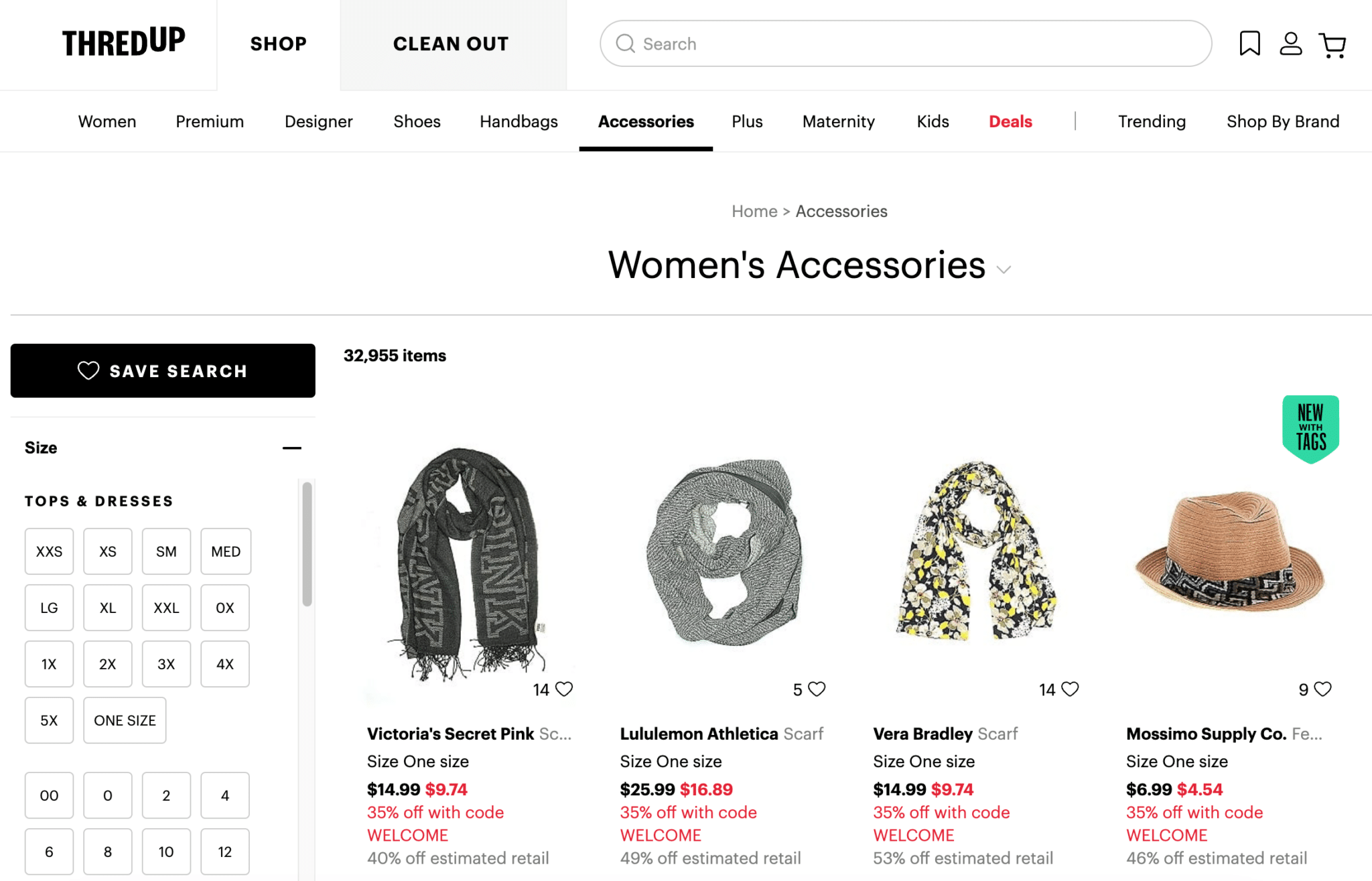
Additionally, don’t limit yourself to a single sales platform. Even local marketplaces can provide additional avenues for selling your refurbished and repackaged goods.
Expanding your reach can help you tap into different markets and increase your chances of selling items quickly.
Create Compelling Listings.
When listing your items for resale, write product descriptions that highlight the product’s features, condition, and benefits.
High-quality images can also significantly improve your listings’ appeal.
If you can find reviews for the items, include them to improve your listing’s social proof.
Bundle and Upsell.
Consider bundling complementary items together or offering additional products to enhance the value of a purchase.
This approach not only helps you move your inventory faster but also allows you to recoup costs more quickly.
When reviewing listings online, inspecting goods at physical liquidation stores, or sorting through the boxes you already purchased, look for items you can bundle together when reselling them.
For instance, pairing a laptop with Bluetooth earbuds can make the deal more attractive to buyers.
Experiment with bundling and pricing techniques until you land on a winning formula. You can offer the second or third items in the bundle at discounted prices to attract buyers.
Using my example above, you can offer a 25% to 30% discount for the Bluetooth earbuds if buyers purchase them with a laptop or smartphone.
How Much Can You Make Reselling Amazon Return Pallets?
The potential profits can vary widely depending on several factors, such as:
- Product quality and condition
- Market demand
- Pricing strategy
- Shipping and handling costs
- Competition
It helps to assess the actual product page on Amazon to review its sales data.
Here’s one way to check the product on Amazon:
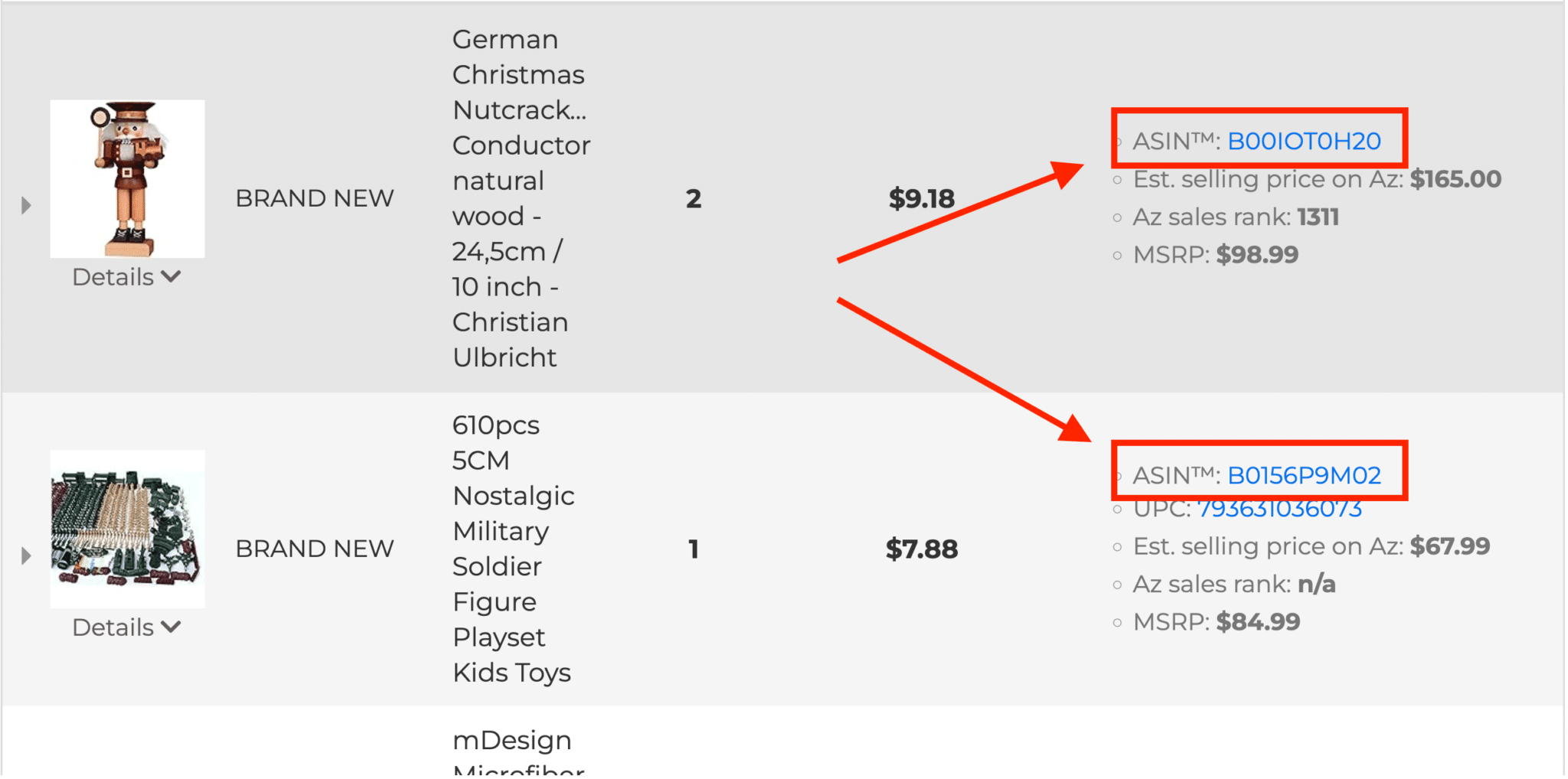
In the manifest, check the product’s Amazon Standard Identification Number (ASIN) if provided.
This ASIN is a unique code assigned to each item in Amazon’s catalog, granting each item a distinct product page on the platform.
Take the ASIN and access the Amazon product page by entering “www.amazon.com/dp/[ASIN]” into your browser.
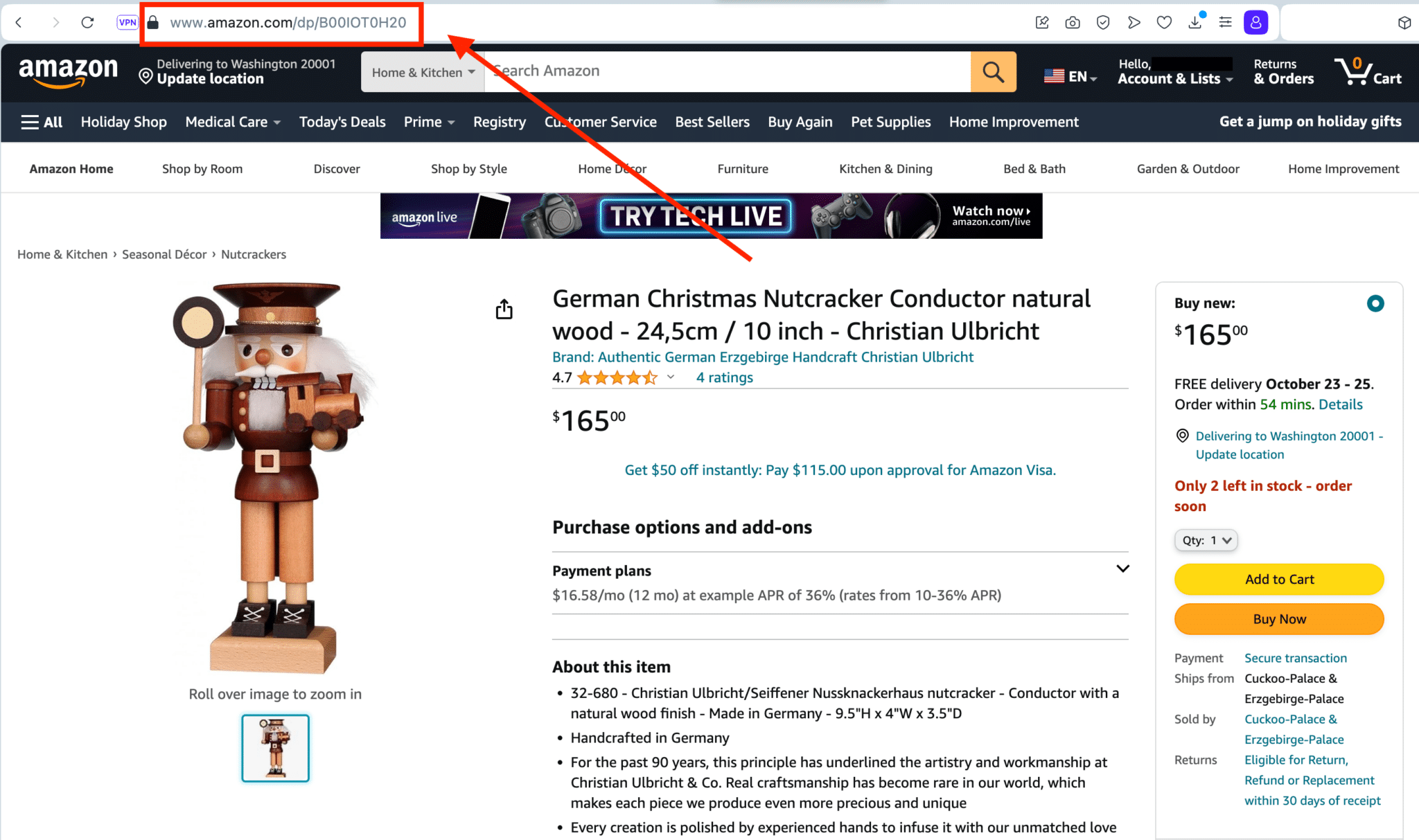
Once you’re in the product page, you can use tools to gather data like its monthly sales. A high number is a good sign you’ll be able to quickly resell the item with a decent profit.
The Pros and Cons of Return Pallets: Are Amazon Return Pallets Worth It?
Here’s a summary table of the pros and cons of buying Amazon liquidation pallets to help you decide whether it’s worth the investment.
| Pros | Cons |
|---|---|
| Amazon return pallets can be an excellent source of inventory if you resell goods on marketplaces like Amazon, eBay, and Shopify | Amazon return pallets aren’t cheap and can cost $1,000 or more. |
| Sometimes, you can buy return pallets at discounted prices and increase the resale value of the goods if you know how to repair and refurbish them. | Shipping a large quantity of items can be expensive and cost more than the price of the return pallet. |
| You can find high-value items much cheaper than their retail prices and sell them with a significant markup. | Buying and reselling returned goods isn’t for those who want to start a business on a limited budget. |
| You help reduce waste by buying Amazon return pallets that will likely end up in landfills if liquidation companies can’t sell them. | Spending thousands of dollars on return pallets doesn’t guarantee you’ll turn a profit. |
| Starting a business reselling returned items doesn’t require technical skills. | Liquidation companies don’t guarantee the condition of goods, meaning you can end up with damaged merchandise, unsellable items, and, sometimes, even empty boxes. |
How To Choose the Right Amazon Pallet: Top Mistakes To Avoid
Avoid these common mistakes to make the best choices when buying return pallets:
Blind Bidding and Ignoring Manifests
One of the biggest mistakes you can make is to blindly bid on Amazon return pallets without thoroughly researching the auction or the liquidation platform.
Blind bidding can lead to unexpected surprises, as you won’t know what you’re getting until you unbox the pallet.
Ignoring manifests can also lead to unpleasant surprises, such as receiving items you can’t resell or items that don’t match your niche.
Neglecting Shipping Costs
Some pallets may seem like a great deal, but hefty shipping fees can quickly eat into your potential profits.
Consider the shipping costs as part of your budgeting process and explore options for cost-effective shipping methods.
Overbidding Due to Competition
Competition for Amazon return pallets can be fierce, with multiple resellers vying for the same lots. It’s easy to get caught up in bidding wars and overpay for a pallet.
To avoid this mistake, set a maximum bid limit based on your budget and stick to it.
Not Diversifying Your Sources
Relying on a single source for Amazon return pallets can limit your options and expose you to risks.
Instead of putting all your eggs in one basket, explore different liquidation platforms, auction sites, and physical liquidation stores.
This approach can help you access a broader range of pallets and minimize the impact if one source doesn’t meet your needs.
Not Understanding Your Risks
You must keep in mind the potential risks associated with certain categories, such as:
- Electronics
These products often come with a higher risk of malfunction or defects. If you lack the expertise to repair electronics, you could end up with items that are difficult to resell or a total loss. - Baby products
Reselling them is extremely difficult due to safety hazards. - Cooking products
These are usually already heavily used and unusable. - Items with multiple parts
The more parts an item has, the higher the chance of missing or damaged components.
These complex items may require extra effort to inspect, assemble, or refurbish, potentially leading to increased costs and reduced profitability.
Risking a Huge Amount of Money
Don’t spend thousands of dollars on your first pallet, regardless of the liquidation platform or store.
Instead, spend a few hundred dollars ($400 to $500) to test the company and see what items you get.
Frequently Asked Questions (FAQs)
Can You Make Money Buying Return Pallets?
It depends. Buying return pallets and reselling the good individually is risky. You can’t guarantee the condition of the returned items and can end up with damaged, low-quality, and unsellable goods.
Buying returned items or Amazon overstock pallets can also be expensive. Try doing a Google search for “$85 Amazon return pallet near me.” I guarantee Google won’t show you any helpful results.
This business model isn’t ideal for individuals who want to start a business on a limited budget.
On the other hand, if you have extra cash to spend and are good at repairing or refurbishing goods, buying return pallets is an excellent way to obtain a ton of inventory for your business at discounted prices.
How Do You Buy Amazon Mystery Boxes?
You must check liquidation websites to see if they have listings that don’t disclose the items or don’t have manifests. My list of reliable liquidation platforms can help you avoid wasting time and money.
The Bottom Line
I hope my guide made it easier for you to understand how to buy Amazon return pallets.
Use the information in my guide to find the most reliable liquidation companies, find the best products at the lowest possible prices, and avoid wasting your money and effort.
If you’re interested in reselling returned items on Amazon, the best Amazon seller tools can help you maximize profits.






